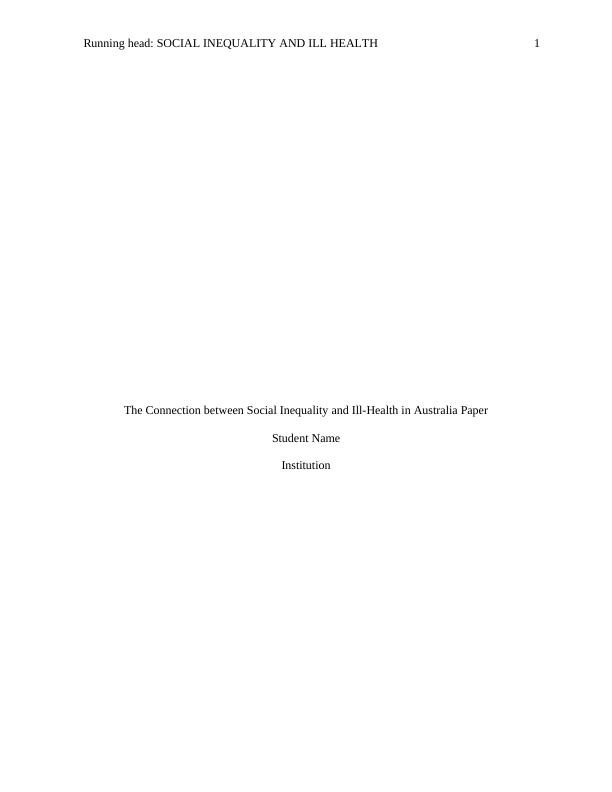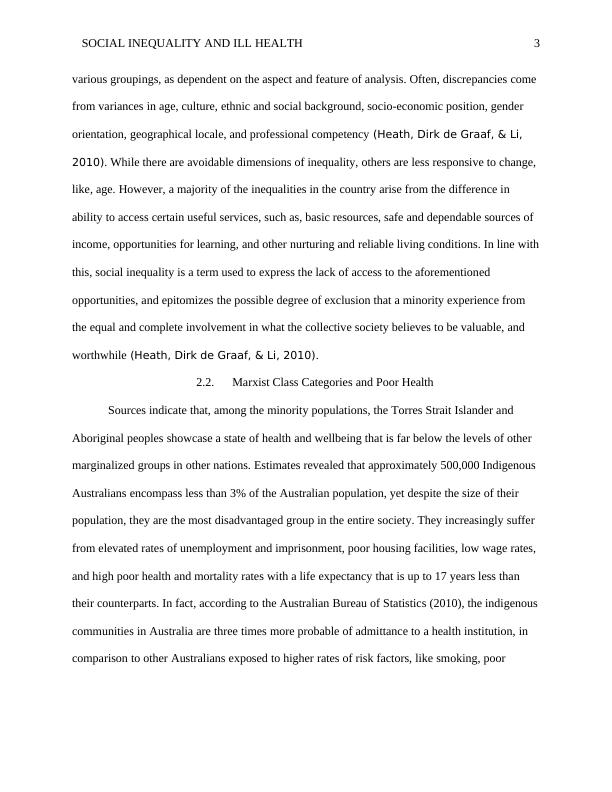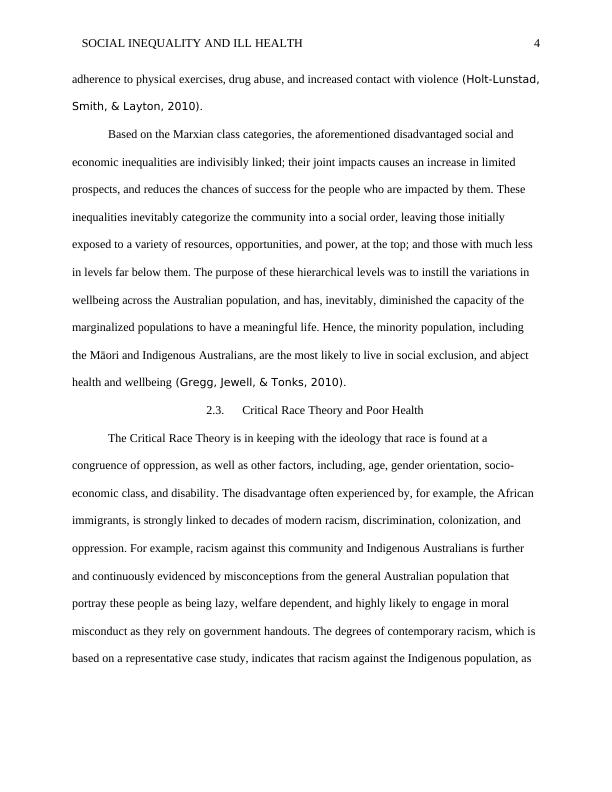The Connection between Social Inequality and Ill-Health in Australia
Added on 2023-01-04
12 Pages3635 Words85 Views
Running head: SOCIAL INEQUALITY AND ILL HEALTH 1
The Connection between Social Inequality and Ill-Health in Australia Paper
Student Name
Institution
The Connection between Social Inequality and Ill-Health in Australia Paper
Student Name
Institution

SOCIAL INEQUALITY AND ILL HEALTH 2
The Connection between Social Inequality and Ill-Health in Australia
1. Introduction
In general, the level of health and wellbeing in Australia is significantly satisfactory when
compared to other countries, as evidenced by the recorded infant death and life expectancy rates
of the entire population. All the same, recent research has uncovered considerable disparities in
the general health of certain groups and communities within the Australian population. For
instance, in comparison to other Australians, the Torres Strait Islander and Aboriginal peoples
are exposed to a wider range of economic and social disadvantages based on pay, schooling,
housing, and health (Glover, Hetzel, Tennant, & Leahy, 2010). Studies suggest that these
discrepancies are most likely resultant of numerous underlying causes, such as, the
intergenerational impacts of obligatory separations from either family, community, land, or
culture, as caused by the long-term effects of racism, segregation, and colonization.
Consequently, this has placed such minority populations at higher risk of inferior life results. For
example, significant evidence has established the presence of decades of poor health among the
Aboriginal and Torres Strait Islander communities, whose health is substantially worse than
those in non-Indigenous populations (Australian Bureau of Statistics, 2010). Hence, the
purpose of this paper is to analyze and discuss the association between poor health and social
inequality in Australia, with regard to the socially-disadvantaged groups in the society.
2. Social Inequality
2.1. Definition
Inequality refers to a situation of dissimilarity. In Australia, there are several kinds of
disparities, such as, health, and social inequalities. Such inequalities have become increasingly
evident across the Australian population, and have caused a rift within the community into
The Connection between Social Inequality and Ill-Health in Australia
1. Introduction
In general, the level of health and wellbeing in Australia is significantly satisfactory when
compared to other countries, as evidenced by the recorded infant death and life expectancy rates
of the entire population. All the same, recent research has uncovered considerable disparities in
the general health of certain groups and communities within the Australian population. For
instance, in comparison to other Australians, the Torres Strait Islander and Aboriginal peoples
are exposed to a wider range of economic and social disadvantages based on pay, schooling,
housing, and health (Glover, Hetzel, Tennant, & Leahy, 2010). Studies suggest that these
discrepancies are most likely resultant of numerous underlying causes, such as, the
intergenerational impacts of obligatory separations from either family, community, land, or
culture, as caused by the long-term effects of racism, segregation, and colonization.
Consequently, this has placed such minority populations at higher risk of inferior life results. For
example, significant evidence has established the presence of decades of poor health among the
Aboriginal and Torres Strait Islander communities, whose health is substantially worse than
those in non-Indigenous populations (Australian Bureau of Statistics, 2010). Hence, the
purpose of this paper is to analyze and discuss the association between poor health and social
inequality in Australia, with regard to the socially-disadvantaged groups in the society.
2. Social Inequality
2.1. Definition
Inequality refers to a situation of dissimilarity. In Australia, there are several kinds of
disparities, such as, health, and social inequalities. Such inequalities have become increasingly
evident across the Australian population, and have caused a rift within the community into

SOCIAL INEQUALITY AND ILL HEALTH 3
various groupings, as dependent on the aspect and feature of analysis. Often, discrepancies come
from variances in age, culture, ethnic and social background, socio-economic position, gender
orientation, geographical locale, and professional competency (Heath, Dirk de Graaf, & Li,
2010). While there are avoidable dimensions of inequality, others are less responsive to change,
like, age. However, a majority of the inequalities in the country arise from the difference in
ability to access certain useful services, such as, basic resources, safe and dependable sources of
income, opportunities for learning, and other nurturing and reliable living conditions. In line with
this, social inequality is a term used to express the lack of access to the aforementioned
opportunities, and epitomizes the possible degree of exclusion that a minority experience from
the equal and complete involvement in what the collective society believes to be valuable, and
worthwhile (Heath, Dirk de Graaf, & Li, 2010).
2.2. Marxist Class Categories and Poor Health
Sources indicate that, among the minority populations, the Torres Strait Islander and
Aboriginal peoples showcase a state of health and wellbeing that is far below the levels of other
marginalized groups in other nations. Estimates revealed that approximately 500,000 Indigenous
Australians encompass less than 3% of the Australian population, yet despite the size of their
population, they are the most disadvantaged group in the entire society. They increasingly suffer
from elevated rates of unemployment and imprisonment, poor housing facilities, low wage rates,
and high poor health and mortality rates with a life expectancy that is up to 17 years less than
their counterparts. In fact, according to the Australian Bureau of Statistics (2010), the indigenous
communities in Australia are three times more probable of admittance to a health institution, in
comparison to other Australians exposed to higher rates of risk factors, like smoking, poor
various groupings, as dependent on the aspect and feature of analysis. Often, discrepancies come
from variances in age, culture, ethnic and social background, socio-economic position, gender
orientation, geographical locale, and professional competency (Heath, Dirk de Graaf, & Li,
2010). While there are avoidable dimensions of inequality, others are less responsive to change,
like, age. However, a majority of the inequalities in the country arise from the difference in
ability to access certain useful services, such as, basic resources, safe and dependable sources of
income, opportunities for learning, and other nurturing and reliable living conditions. In line with
this, social inequality is a term used to express the lack of access to the aforementioned
opportunities, and epitomizes the possible degree of exclusion that a minority experience from
the equal and complete involvement in what the collective society believes to be valuable, and
worthwhile (Heath, Dirk de Graaf, & Li, 2010).
2.2. Marxist Class Categories and Poor Health
Sources indicate that, among the minority populations, the Torres Strait Islander and
Aboriginal peoples showcase a state of health and wellbeing that is far below the levels of other
marginalized groups in other nations. Estimates revealed that approximately 500,000 Indigenous
Australians encompass less than 3% of the Australian population, yet despite the size of their
population, they are the most disadvantaged group in the entire society. They increasingly suffer
from elevated rates of unemployment and imprisonment, poor housing facilities, low wage rates,
and high poor health and mortality rates with a life expectancy that is up to 17 years less than
their counterparts. In fact, according to the Australian Bureau of Statistics (2010), the indigenous
communities in Australia are three times more probable of admittance to a health institution, in
comparison to other Australians exposed to higher rates of risk factors, like smoking, poor

SOCIAL INEQUALITY AND ILL HEALTH 4
adherence to physical exercises, drug abuse, and increased contact with violence (Holt-Lunstad,
Smith, & Layton, 2010).
Based on the Marxian class categories, the aforementioned disadvantaged social and
economic inequalities are indivisibly linked; their joint impacts causes an increase in limited
prospects, and reduces the chances of success for the people who are impacted by them. These
inequalities inevitably categorize the community into a social order, leaving those initially
exposed to a variety of resources, opportunities, and power, at the top; and those with much less
in levels far below them. The purpose of these hierarchical levels was to instill the variations in
wellbeing across the Australian population, and has, inevitably, diminished the capacity of the
marginalized populations to have a meaningful life. Hence, the minority population, including
the Māori and Indigenous Australians, are the most likely to live in social exclusion, and abject
health and wellbeing (Gregg, Jewell, & Tonks, 2010).
2.3. Critical Race Theory and Poor Health
The Critical Race Theory is in keeping with the ideology that race is found at a
congruence of oppression, as well as other factors, including, age, gender orientation, socio-
economic class, and disability. The disadvantage often experienced by, for example, the African
immigrants, is strongly linked to decades of modern racism, discrimination, colonization, and
oppression. For example, racism against this community and Indigenous Australians is further
and continuously evidenced by misconceptions from the general Australian population that
portray these people as being lazy, welfare dependent, and highly likely to engage in moral
misconduct as they rely on government handouts. The degrees of contemporary racism, which is
based on a representative case study, indicates that racism against the Indigenous population, as
adherence to physical exercises, drug abuse, and increased contact with violence (Holt-Lunstad,
Smith, & Layton, 2010).
Based on the Marxian class categories, the aforementioned disadvantaged social and
economic inequalities are indivisibly linked; their joint impacts causes an increase in limited
prospects, and reduces the chances of success for the people who are impacted by them. These
inequalities inevitably categorize the community into a social order, leaving those initially
exposed to a variety of resources, opportunities, and power, at the top; and those with much less
in levels far below them. The purpose of these hierarchical levels was to instill the variations in
wellbeing across the Australian population, and has, inevitably, diminished the capacity of the
marginalized populations to have a meaningful life. Hence, the minority population, including
the Māori and Indigenous Australians, are the most likely to live in social exclusion, and abject
health and wellbeing (Gregg, Jewell, & Tonks, 2010).
2.3. Critical Race Theory and Poor Health
The Critical Race Theory is in keeping with the ideology that race is found at a
congruence of oppression, as well as other factors, including, age, gender orientation, socio-
economic class, and disability. The disadvantage often experienced by, for example, the African
immigrants, is strongly linked to decades of modern racism, discrimination, colonization, and
oppression. For example, racism against this community and Indigenous Australians is further
and continuously evidenced by misconceptions from the general Australian population that
portray these people as being lazy, welfare dependent, and highly likely to engage in moral
misconduct as they rely on government handouts. The degrees of contemporary racism, which is
based on a representative case study, indicates that racism against the Indigenous population, as

End of preview
Want to access all the pages? Upload your documents or become a member.
Related Documents
Determinants of Health Discrepancies in Australialg...
|11
|3022
|456
Why Indigenous Peoples Globally Experience Health Disparitieslg...
|6
|1388
|12
Paper on Health of Indigenous and Non-indigenous Australianslg...
|8
|2422
|59
Bachelor of Nursing Healthlg...
|8
|1851
|42
Social Determinants of Mental Healthlg...
|9
|2136
|155
Health Inequalities Between Aboriginal and Non-Indigenous Populationslg...
|6
|1262
|17
